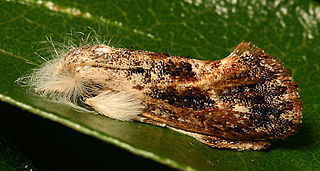
The deepwater sicklefin houndshark or the darksnout houndshark, is a houndshark of the family Triakidae. It is found in the western central Pacific, in the Coral Sea off Queensland and in the waters off New Caledonia.

Acrolophus is a genus of moths in the family Acrolophidae, with, typically, great individual variation within species in color pattern, making field identification of many individuals difficult or impossible. It was described by Felipe Poey in 1832.

Clemens' grass tubeworm moth is a moth of the family Acrolophidae. It is found in the eastern United States, from New Jersey and Ohio south to Florida and west to Illinois, Nebraska and Texas.
Acrolophus fervidus is a moth of the family Acrolophidae described by August Busck in 1912. It is found in Costa Rica, Mexico and Texas.
Acrolophus arcasalis is a moth of the family Acrolophidae. It is found in the West Indies.
Acrolophus salvini is a moth of the family Acrolophidae. It is found in Panama.
Acrolophus australis is a moth of the family Acrolophidae. It is found in the West Indies.

The Grass Tubeworm or Texas Grass Tubeworm Moth is a moth of the family Acrolophidae. It is found from Maryland to Florida and to Texas.
Acrolophus macrogaster is a moth of the family Acrolophidae. It is found in North America, including Arizona.
Walsingham's grass tubeworm moth is a moth of the family Acrolophidae. It is found in North America, including Alabama, Florida, Georgia, Illinois, Louisiana, Maryland, Mississippi, New York, Ohio, South Carolina, Tennessee, Virginia and West Virginia.
Acrolophus echinon is a moth of the family Acrolophidae. It is found in Mexico.
Acrolophus garleppi is a moth of the family Acrolophidae. It is found in Bolivia.
Acrolophus hamiferella is a moth of the family Acrolophidae. It is found in South America.
Acrolophus harparsen is a moth of the family Acrolophidae. It is found in Puerto Rico.
Acrolophus jalapae is a moth of the family Acrolophidae. It is found in South America.
Acrolophus maculata is a moth of the family Acrolophidae. It is found in Brazil.
Acrolophus numidia is a moth of the family Acrolophidae. It is found in Mexico.
Acrolophus walsinghami is a moth of the family Acrolophidae. It is found in Puerto Rico.

Favites abdita, also known as the larger star coral, is a species of stony coral in the family Merulinidae. It is native to the Indo-Pacific region and its range extends from East Africa and the Red Sea through the Indian Ocean to the Western Pacific Ocean. The International Union for Conservation of Nature has rated its conservation status as being "near-threatened".
Abdita is a Syrian village located in Ihsim Nahiyah in Ariha District, Idlib. According to the Syria Central Bureau of Statistics (CBS), Abdita had a population of 1440 in the 2004 census.






